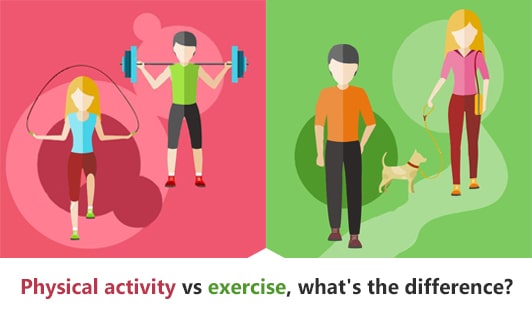Physical activity vs exercise, what's the difference?
- 25 months ago
Are you confused about the difference between physical activity and exercise? Well, you're not alone! While both require movement, they're quite different.
Physical activity is like the fun-loving cousin who always shows up unannounced and is ready for a good time. It can be anything from playing with your dog to dancing to your favorite music in the living room. You do not require special equipment, or a strategy only move your body and have fun.
Whereas exercise is more like the responsible older sibling who sets goals and plans to achieve them. It's a structured form of physical activity specific to improving your fitness level. Think jogging, weightlifting, or taking a yoga class. Exercise is planned and intentional. You require special equipment or a gym membership.
While physical activity is good for overall health, exercise has specific health benefits. Regular exercise reduces the risk of chronic diseases such as heart disease, diabetes, and some cancers. Exercise can also improve mental health, cognitive function, and overall quality of life. Additionally, exercise can help maintain a healthy weight and promote healthy aging.
Differences between physical activity and exercise
- Intensity: Physical activity can range from low to high intensity, whereas exercise is done at a moderate to high-intensity level.
- Duration: Physical activity can be performed for short or long periods, while exercise is usually performed for a set duration, often ranging from 30 minutes to an hour.
- Purpose: Physical activities are done for various reasons, such as recreation, transportation, or daily tasks. Exercise is to improve physical fitness, health, or athletic performance.
- Frequency: Physical activity can be performed occasionally or regular basis. Exercise is done regularly, often several times each week.
- Variety: Physical activity can involve various types of movement, such as walking, gardening, and household chores, while exercise typically involves a more limited range of activities, such as running, weightlifting, or cycling.
- Intentionality: Physical activity can be intentional or unintentional (for example, walking around during the day), whereas exercise is always intentional and planned.
- Goals: Physical activity may have different goals than exercise, such as stress reduction, enjoyment, or social interaction. Exercise, on the other hand, is typically done for the purpose of achieving specific health or fitness goals.
|
Physical activity |
Exercise |
|
|
Intensity |
Range from low to high intensity |
Range from moderate to high intensity level |
|
Duration |
No fixed duration |
Set duration (30-45 mins) |
|
Purpose |
No fixed purpose (variety of reasons) |
For improving physical fitness |
|
Frequency |
Can be done occasional or regular |
Done Regularly (several times per week.) |
|
Variety |
Walking, gardening, and household chores |
Running, weightlifting, and cycling |
|
Intentionality |
Intentional or unintentional |
Always intentional and planned |
|
Goals |
No specific goal |
Specific health or fitness goals |
The benefits of physical activity and exercise:
The benefits of physical activity and exercise are identical. The only thing that matters is that we keep our bodies moving. Here are some benefits:
- Improved physical fitness: improves cardiovascular endurance, muscular strength, flexibility, and balance.
- Weight management: burns more calories and can be more effective for weight loss or weight management.
- Reduced risk of chronic diseases: reduce the risk of chronic diseases, such as heart disease, diabetes, and cancer.
- Improved mental health: reduces stress, anxiety and improves overall mood and well-being.
Conclusion
Physical activity can be done in various ways throughout the day and has multiple benefits, including increased cardiovascular health, muscle strength, weight control, and mental health. An exercise is a type of physical activity that is pre-planned, structured, and performed to improve one or more aspects of physical fitness. Exercise can also bring additional benefits such as enhanced physical fitness, a lower risk of chronic diseases, and a higher ability to manage weight. Whatever you choose, including physical activity or exercise in your daily routine can improve your general health and well-being.




